Eastport Plaza Neither Walkable Nor Accessible
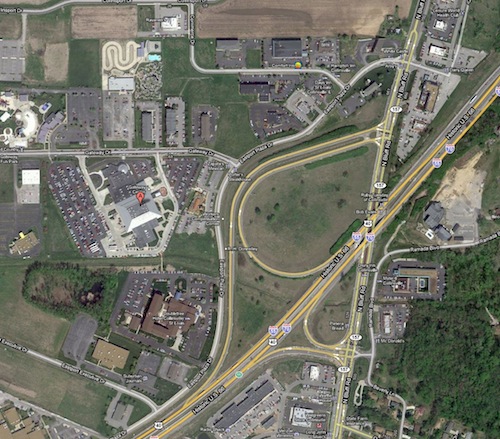
Sure, you can walk at Collinsville’s Eastport Plaza, but it isn’t easy. Â I navigated the area in my wheelchair, but it wasn’t pleasant or even ADA-compliant. Â Planned as a Metro East version of Westport Plaza in St. Louis County.
Based on my research, Eastport Plaza was platted in the early 1980s. Â This is a decade before the ADA but walkable environments have been built for centuries. Â This was an auto-centric development with token sidewalks. Â The post is a follow up to my post from a week ago.
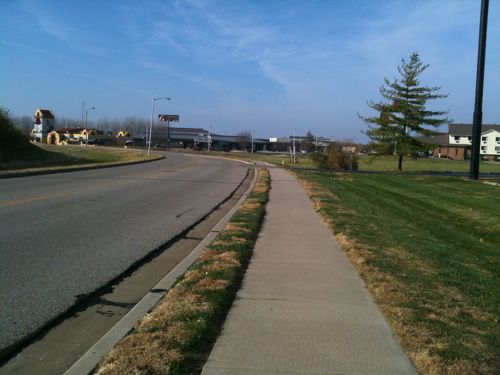
The width of the roads are excessive for two lanes. Â This, along with a lack of street trees, diminish the pedestrian experience.
Gateway Center, in the middle of Eastport Plaza, talks about the area:
“The only hospitality district in Collinsville accommodates events at Gateway Center with more than 900 hotel rooms in a variety of hotel properties, and 60 restaurants ranging from casual family dining to fine dining. Another 2,100 hotel rooms are conveniently located within a 20-minute driving radius of the convention center for overflow accommodations.
Most of Collinsville’s lodging is within walking distance of the convention center.”
Walking distance, but not walkable.
What I don’t yet know is: the developer, the engineer responsible, or the level of involvement from Collinsville. Â I do know the area has boomed since Illinois changed it’s TIF law, from the St. Louis Post-Dispatch Monday, March 28, 1988:
“East St. Louis, Belleville and Collinsville are among cities whose tax increment finance (TIF) districts are criticized in a recent report by the Taxpayers Federation of Illinois. [The ]Â report shows illustrations of TIF districts under headings of ”The Good, The Bad and The Ugly.”
Collinsville’s TIF district is listed under ”The Ugly. ” The report says a 500-acre tract of mostly undeveloped land at the city’s northwest edge was hooked to its central business district by a strip one block wide and several miles long.
Mayor Brombolich said the federation’s labeling his city’s TIF district ugly because of its shape illustrates what happens when someone tries to generalize without adequate knowledge. Â The city’s rapidly developing Eastport Plaza area was linked to its comparatively stagnant downtown area to obtain money to help revive the central business district, Brombolich said.
Collinsville’s TIF ordinance does not allow sale of bonds, but requires a pay-as-you-go policy, he added. ”We have not spent a penny of TIF money up to this date.”
About $100,000 has been accumulated through growth in sales and real estate taxes at Eastport, and three downtown projects are planned, he said.
They are new curbs and sidewalks around a block where Home Federal Savings & Loan Co. plans a new building, a sprinkling system and other improvements to allow the old Miners Theater to reopen its upper level, and re-paving of part of Clay and Church streets.”

By February 2007 the area was booming; from the Post-Dispatch:
“City leaders are overseeing development on more than half a million square feet of office and warehouse space on the city’s west side that is expected to create at least 1,000 jobs.
Fourteen businesses are opening in the area known as Eastport Plaza, which is mostly east of Interstate 255 and north of Interstate 55-70. The businesses include Floors Inc., a commercial and residential floor company, and Tetra Tech, an engineering firm. Officials expect more businesses to move there by the end of the year.”
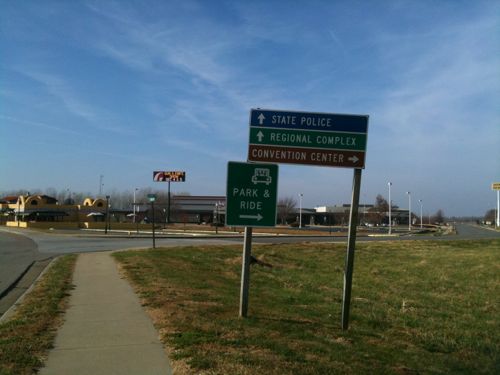 The vast majority of those who come to Eastport Plaza do so in a private vehicle. Â But the area is served by a Madison County bus (#15 Collinsville Shuttle), which was how I arrived on a recent visit. Â No matter how someone arrives in the area I have an expectation that within the relatively small area that walking would be encouraged as an alternative to driving short distances.
The vast majority of those who come to Eastport Plaza do so in a private vehicle. Â But the area is served by a Madison County bus (#15 Collinsville Shuttle), which was how I arrived on a recent visit. Â No matter how someone arrives in the area I have an expectation that within the relatively small area that walking would be encouraged as an alternative to driving short distances.
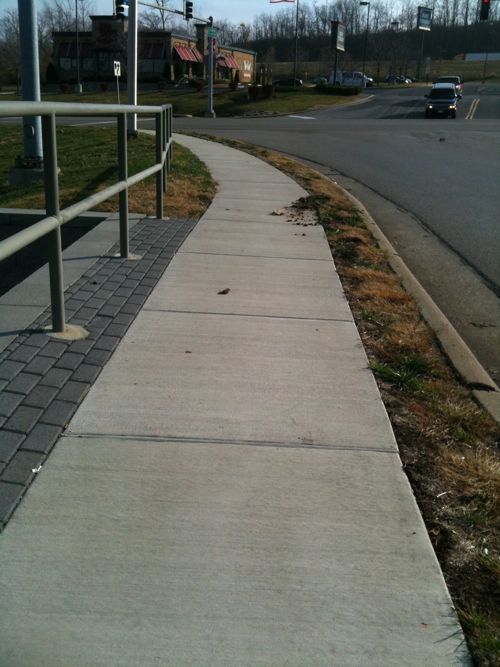
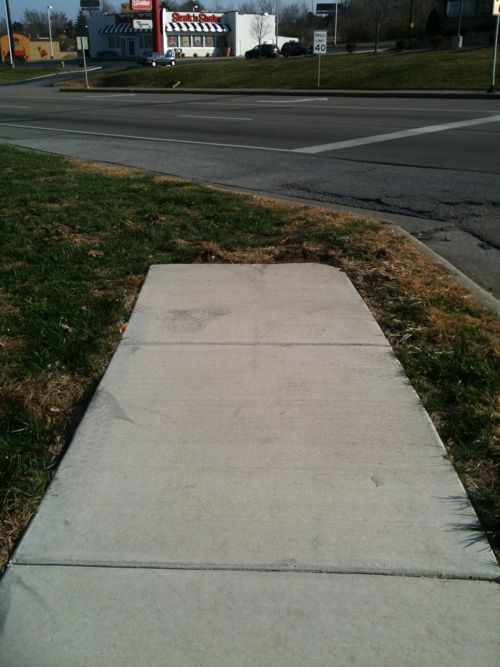
These 300 acres were flat farm land before being developed. Â The developer had a complete blank slate to work with but clearly making a walkable environment wasn’t a priority. Â The sidewalk is just there to create a passing appearance of walkability. Â Say what you will about New Urbanism but those principles would have created a far more satisfying environment.
– Steve Patterson
– Steve Patterson
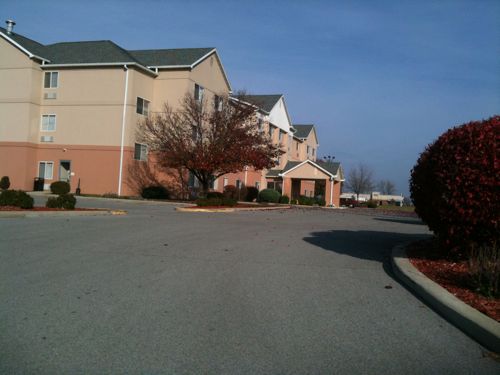
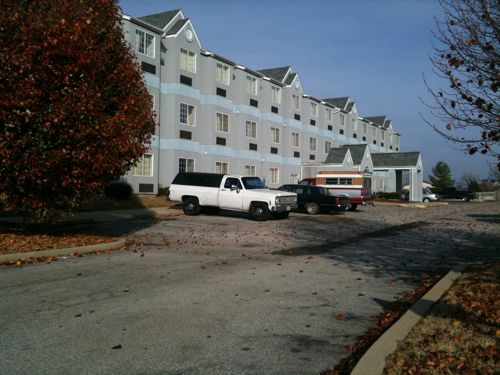
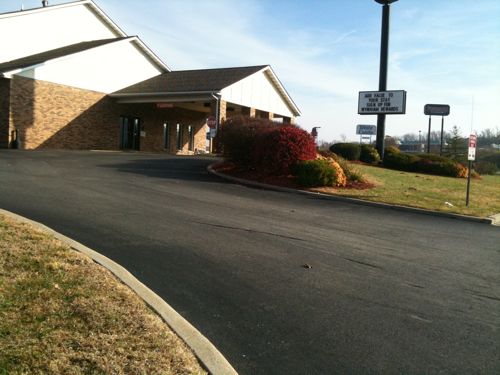
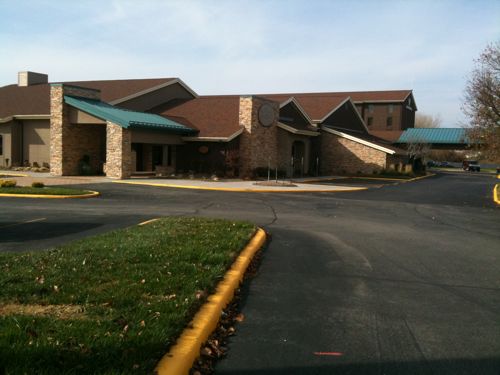
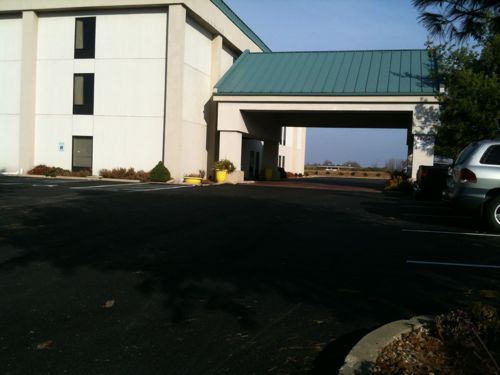
Westport in Maryland Heights is the same way.
For about a year ending in the summer of '09 I worked at the new (one year old) Ameren offices of Eastport Plaza Dr. (upper left by the waterpark) Ameren has since closed and these offices moved back to downtown STL and Peoria leaving the building vacant. The land was prepared to develop two other office buildings before Ameren moved away. Imo, it is doubtful that these buildings will be built in the near future.
The development along this road including sidewalks occurred during this period ('08-'09). Often I would walk down the sidewalkless road and the edge of the soybean field to the nearby food joints.
My initial response is “yeah, so what?” This and the many, many other developments that have their roots in the '60's, '70's & '80's were conceived and executed assuming that the single-occupant vehicle was/is the only answer. Walking, public transit and ADA compliance weren't a part of any planning; providing surface parking for buildings dispersed in parklike settings in what used to be cornfields was. Putting in fully-ADA-compliant sidewalks now really won't do much to make these suburban office parks walkable; they're simply too spread out and autocentric to be attractive to very many pedestrians. The only real solution is to nuke 'em and start over, with much higher densities and a better balance between automotive and pedestrian investments and amenities. Putting lipstick an a pig . . .
Steve, while I agree with you 100% on the accessibility/walkability issues of the Gateway Center area, it's not unique and, as you mentioned, typical of the auto-centric time period it was designed. While some improvements are being made to catch up with the times it's still lacking especially for the disable. Change won't happen overnight. Be thankful it's flat and can be upgraded. Since most of Collinsville lies in the hills, you can't bulldoze the entire town to a 5% or less grade.
The thing that disappoints me the most about your blog is your general lack of thorough reporting and short sightedness. I deal with ADA design and construction issues on a daily basis. I understand and am sympathetic to the needs of the disabled – not only wheelchair bound, but also vision and hearing impaired, those with cognizant and learning disabilities, etc. While you dwell on the stairs/steps that cross the drainage ditch, you fail to mention that there REALLY IS an accessible route (sidewalk) along the roadway from the Convention Center to the Double Tree hotel. You can easily see it on Bing or Google maps if you care.
The same sidewalks leading to the Gateway Center also connect to other accessible sidewalks (according to ADA guidelines at the time of being built) through the Eastport area and connect to many of the hotels and eating establishments as well. Highway 157, which is actually outside the Eastport development limits, will probably never have sidewalks. It was designed and built as a rural highway and sits at the base of the bluffs. It would cost millions of dollars to convert it to urban. The section of 157 that does contain sidewalks is in and around the new Collinsville Crossing shopping center area, which itself is mostly void of sidewalks and probably lends itself as a better topic of non-accessibility than a 30 year old development, especially since it was recently built.
I do have to disagree with you on the walkability issue as well. There has been a concerted effort for developers to include sidewalks as sites are built. As you probably saw, the area is built up to about 25% capacity at most. Most walkers/joggers use the 5-6 shoulders that are readily accessible and not that intimidating since traffic along the “non-sidewalked” roads have relatively low traffic. You also failed to mention the “bikeability” opportunities from the Convention Center to the Schoolhouse Bike Trail to the north, which itself is almost entirely accessible.
You took the time to show where the sidewalk ends at Highway 157 but failed to mention the same route takes you from the Convention Center to the hotel. You really should do a more “all encompassing” analysis of the areas before flying off the handle with one pedestrian bridge issue.
The route from the convention center to the hotel is very long, far longer than the direct path over the ditch. That is not an equal route. Plus when you arrive at the hotel there is no route, other than the auto drive, to enter.
But there ARE routes. Sure I'd like to wheel downhill both directions, but that's not realistic. The argument against Eastport is a little unfounded although everyone has an opinion. If you really wanted to throw something out there you should take a closer look at Collinsville Crossing, which is new and should have ped/handicap amenities…..but doesn't. When it comes to the almighty dollar, most developers will nix the idea of 'wasting' space on sidewalks, trails, etc. By the way, this was a Koman development.
Yes, there are routes that are much longer and still don't get you door to door. That is like saying we serve food to African-Americans, just from a back window.
Poor analogy by comparing this issue with one of race. Childish at best.
Not at all – the ADA IS civil rights legislation, not a building code . . .
Yes, I agree in the context of civil rights the analogy rings true but in the context of pure discrimination and persecution it's not a valid comparison. Could have been my misunderstanding on how the comparison was meant.
Okay, back to our regularly scheduled debate. The point I'm really trying to get across is that you can go to most developments aged 30 years or more and find little to no pedestrian, ADA, or “Great Streets” accommodations. While ADA was around in the 90s it really hasn't been required for use within public rights of ways (and still isn't law) until the Feds got busy in the last 10 years. Squawking about a 30+ year old development is likened to being critical about development of 100 years ago not taking ADA issues into consideration. While everyone is entitled to their own opinion, I feel that being critical about something a little more applicable has merit.
I agree on 30+. I don't agree on 20, 15, 10 or, especially, more recent construction. Enforcement of the ADA is reactive, not proactive. Someone has to complain or sue, after the fact. Yes, there was much that was constructed between 1990 and 2000 that does not comply. This doesn't make it right – just because (too) many people chose to ignore the ADAAG regulations, out of either ignorance or because they thought they could “get away with it”, doesn't give non-complying properties a pass now. And yes it IS the law!
Yes, I think that anything newer than 30 years needs to be applicable, but in many instances isn't (i.e. my comment about the Collinsville Crossing development). My reference to this area and the ADAAG guidelines is purely within public rights of way, which unless it was recently passed, still isn't law as far as I know (been in draft since 2002 and amended through the years). It should still be used on project with or without federal funding (feds require it to be used as a part of their funding). Specifically what is happening in this are is that sidewalks are being 'infilled' as developments happen. While this should have been a part of design, it wasn't and was typical of the time it was constructed.
Better spaces were built 100 years ago! I'm more concerned with the overal lack of walkability than when various ADA guidelines became applicable.
100 years ago, most people didn't have cars, and DID walk. Today, most people choose to drive, and only walk between the parking space and the front door – informs one definition of “better”!
The problem is we've turned auto driving from a choice to a requirement. I fully accept 99.9% of people coming to Eastport will do so in a car, but why does that have to mean they must use that csr to go 300 feet?
too damn lazy! 😉
Not at all, the same people will walk when they are in spaces designed for walking. You get what you design for!
An interesting tangent involves whether or not mobility scooters / electric wheelchairs are vehicles. Legally and logically, someone in a manual wheelchair is considered to be a pedestrian. But when the motor reaches a certain size, they apparently become vehicles, at least in some states. From an article in the St. Petersburg (FL) Times, involving a fatal collision between a scooter and a mobility chair, on a public street, not on a sidewalk, the operator of the mobility chair, who survived:
“If considered a pedestrian, a charge could be as simple as jaywalking. If he was operating a vehicle, it could be as serious as reckless driving.
The decision could boil down to the size of the wheelchair motor.
“There's issues in there about wattage, horsepower, things like that,” St. Petersburg police spokesman Mike Puetz said. “Speed is also a factor. They want to get to a point where they have a comfort level.”
The case could have repercussions in a city where motorized wheelchairs, also known as mobility scooters, are common on streets and sidewalks.
People operating wheelchairs typically are considered pedestrians. But because Kurczaba's wheelchair is motorized, police said they will examine the accident in greater detail before considering whether charges should be filed.”
http://www.tampabay.com/news/publicsafety/accidents/fatal-st-petersburg-scooter-wheelchair-crash-raises-unusual-questions/1137488
There are two tangential issues. The steps are obviously a barrier to a manual wheelchair, and should be improved. But are they a barrier to either a mobility scooter or a lift- or ramp-equipped van? Since they're both legally vehicles? There is no ADA requirement for a direct vehicle route, just for designated parking. And, should the hotel provide a lift-equipped shuttle van, assuming they have one that is used to shuttle guests between the hotel and the convention center? Hmmm . . .
It is also devastatingly ugly and has absolutely no unity. Same with Westport Plaza.
Not at all, the same people will walk when they are in spaces designed for walking. You get what you design for!